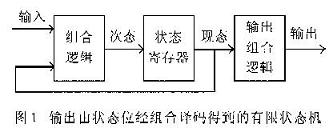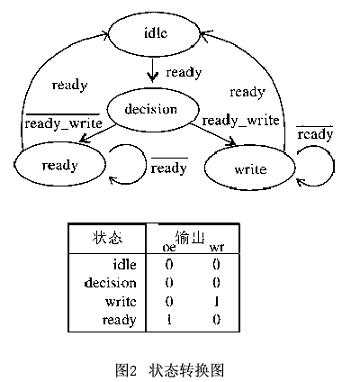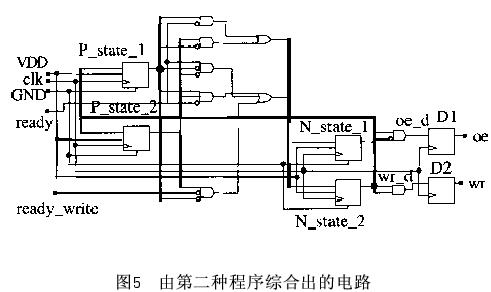VHDL设计MOORE型有限状态机时速度问题的探讨
时间:09-25
来源:互联网
点击:
1 引言
随着微电子技术的迅速发展,人们对数字系统的需求也在提高。不仅要有完善的功能,而且对速度也提出了很高的要求。对于大部分数字系统,都可以划分为控制单元和数据单元两个组成部分。通常,控制单元的主体是一个有限状态机,它接收外部信号以及数据单元产生的状态信息,产生控制信号序列。MOORE型有限状态机的设计方法有多种,采用不同的设计方法,虽然可以得到相同功能的状态机,但它们的速度、时延特性、占用资源可能有较大的差异。在某些对速度要求很高的场合,如内存控制器,则需要针对速度进行优化设计。
2 MOORE型有限状态机的几种设计方法
2.1 输出由状态位经组合译码得到
它的实现方案是:现态与输入信号经组合逻辑得到次态,在时钟的上升沿到来时,状态寄存器将次态锁存得到现态,现态经过输出组合逻辑译码得到输出信号。如图 1所示。由于输出必须由现态的状态位经过译码得到,这就需要在现态与输出之间增加一级组合译码逻辑,从而加大了从状态位到器件输出管脚的传输延迟,同样也增加了时钟-输出时延TCO。

假设一个简单的内存控制器的状态转换图如图2所示。一个完整的读写周期是从空闲状态idle开始。在ready信号有效之后的下一个时钟周期转移到判断状态decision,然后根据read_write信号再转移到read或write状态。则采用这种设计方法的VHDL源程序如下:

signalpresent_state,next_state:std_logic_vector(1 downto 0);
process(clk,ready,read_write,present_state)
begin
if(clk'eventandclk='1')then
casepresent_stateis
when idle=>oe<='0';wr<='0';
if ready='1' then
next_state<=decision;
else next_state<=idle;
endif;
when decision=>oe<='0';wr<='0';
if(read_write='1')then
next_state<=read;
else next_state<=write;
endif;
when read=>oe<='1';wr<='0';
if(ready='1')then
next_state<=idle;
else next_state<=read;
endif;
when others=>oe<='0';wr<='1';
if(ready='1')then next_state<=idle;
else next_state<=write;
endif;
endcase;endif;
endprocess;
state_clock:process(clk)begin
if(clk'eventandclk='1')then
present_state<=next_state;
endif;
endprocess;
对此程序综合出的电路如图3所示。现态present_state与次态next_state均由两个触发器构成,输出wr和oe均由 present_state经组合译码得到,因此从时钟的上升沿到状态机输出的延迟为通过逻辑阵列的时钟-输出时延TCO2,而不是较短的时钟-输出时延 TCO,且输出信号wr,oe直接来自组合逻辑电路,因而可能有毛刺发生。

2.2 输出由并行输出寄存器译码得到
在第一种方法中,主要由于输出组合逻辑引入了延时,从而加大了时钟-输出时延。为了缩短状态机输出到达管脚的延时,可以在锁存状态位之前,先进行输出的组合逻辑译码并将其锁存到专用寄存器中,时钟上升沿到来时,专用寄存器中直接输出wr和oe而没有了组合逻辑引入的延时,从而使状态机输出的延迟为TCO。实现该方案的方框图如图4。采用这种设计方法的VHDL源程序如下:

signalpresent_state:std_logic_vector(1 downto 0);
signalnext_state:std_logic_vector(1 downto 0);
signalwr_d,oe_d:std_logic;
begin
process(clk,ready,read_write)
begin
if(clk'event and clk='1')then
case present_stateis
when idle=>
if ready='1'thennext_state<=decision;
else next_state<=idle;
endif ;
when decision=>
if(read_write='1') then next_state<=read;
else next_state<=write;
endif;
when read=>
if(ready='1')then
next_state<=idle;
else next_state<=read;
endif;
when others=>
if(ready='1')then
next_state<=idle;
else next_state<=write;
endif;
endcase;
endif;
endprocess;
withnext_stateselect
oe_d<='0' whenidle|decision|write,'1'when others;
withnext_stateselect
wr_d<='0'whenidle|decision|read,'1'when others;
state_clock:process(clk)
begin
if(clk'eventandclk='1')then
present_state<=next_state;
oe<=oe_d;
wr<=wr_d;
endif;
endprocess;
在此程序中,用到了两个新的信号oe_d和wr_d,对次态next_state进行锁存,不象第一种方案中将现态present_state进行译码从而得到在下一个时钟周期oe和wr的取值。对此程序综合出的电路如图5所示。oe_d和wr_d作为锁存器D1和D2的输入。因此D1、D2的输出为上一个次态(即现态)的值。clk的上升沿到来时,D1、D2即将oe_d和wr_d锁存,从而得输出oe和wr。因此从时钟的上升沿到状态机输出的延迟为时钟-输出时延TCO而不是通过逻辑阵列的时钟-输出时延TCO2。又由于时钟信号将输出加载到附加的D触发器中,因而消除了输出信号的毛刺。然而,这种方法存在两个缺点:(1)由于用到了输出寄存器,它比第一种设计需要多用两个寄存器;(2)虽然它的时钟-输出时延从TCO2减小到TCO,但从状态机的状态位到达oe和wr需要经过两级组合逻辑,这就影响了系统时钟的最高频率。

随着微电子技术的迅速发展,人们对数字系统的需求也在提高。不仅要有完善的功能,而且对速度也提出了很高的要求。对于大部分数字系统,都可以划分为控制单元和数据单元两个组成部分。通常,控制单元的主体是一个有限状态机,它接收外部信号以及数据单元产生的状态信息,产生控制信号序列。MOORE型有限状态机的设计方法有多种,采用不同的设计方法,虽然可以得到相同功能的状态机,但它们的速度、时延特性、占用资源可能有较大的差异。在某些对速度要求很高的场合,如内存控制器,则需要针对速度进行优化设计。
2 MOORE型有限状态机的几种设计方法
2.1 输出由状态位经组合译码得到
它的实现方案是:现态与输入信号经组合逻辑得到次态,在时钟的上升沿到来时,状态寄存器将次态锁存得到现态,现态经过输出组合逻辑译码得到输出信号。如图 1所示。由于输出必须由现态的状态位经过译码得到,这就需要在现态与输出之间增加一级组合译码逻辑,从而加大了从状态位到器件输出管脚的传输延迟,同样也增加了时钟-输出时延TCO。

假设一个简单的内存控制器的状态转换图如图2所示。一个完整的读写周期是从空闲状态idle开始。在ready信号有效之后的下一个时钟周期转移到判断状态decision,然后根据read_write信号再转移到read或write状态。则采用这种设计方法的VHDL源程序如下:

signalpresent_state,next_state:std_logic_vector(1 downto 0);
process(clk,ready,read_write,present_state)
begin
if(clk'eventandclk='1')then
casepresent_stateis
when idle=>oe<='0';wr<='0';
if ready='1' then
next_state<=decision;
else next_state<=idle;
endif;
when decision=>oe<='0';wr<='0';
if(read_write='1')then
next_state<=read;
else next_state<=write;
endif;
when read=>oe<='1';wr<='0';
if(ready='1')then
next_state<=idle;
else next_state<=read;
endif;
when others=>oe<='0';wr<='1';
if(ready='1')then next_state<=idle;
else next_state<=write;
endif;
endcase;endif;
endprocess;
state_clock:process(clk)begin
if(clk'eventandclk='1')then
present_state<=next_state;
endif;
endprocess;
对此程序综合出的电路如图3所示。现态present_state与次态next_state均由两个触发器构成,输出wr和oe均由 present_state经组合译码得到,因此从时钟的上升沿到状态机输出的延迟为通过逻辑阵列的时钟-输出时延TCO2,而不是较短的时钟-输出时延 TCO,且输出信号wr,oe直接来自组合逻辑电路,因而可能有毛刺发生。

2.2 输出由并行输出寄存器译码得到
在第一种方法中,主要由于输出组合逻辑引入了延时,从而加大了时钟-输出时延。为了缩短状态机输出到达管脚的延时,可以在锁存状态位之前,先进行输出的组合逻辑译码并将其锁存到专用寄存器中,时钟上升沿到来时,专用寄存器中直接输出wr和oe而没有了组合逻辑引入的延时,从而使状态机输出的延迟为TCO。实现该方案的方框图如图4。采用这种设计方法的VHDL源程序如下:

signalpresent_state:std_logic_vector(1 downto 0);
signalnext_state:std_logic_vector(1 downto 0);
signalwr_d,oe_d:std_logic;
begin
process(clk,ready,read_write)
begin
if(clk'event and clk='1')then
case present_stateis
when idle=>
if ready='1'thennext_state<=decision;
else next_state<=idle;
endif ;
when decision=>
if(read_write='1') then next_state<=read;
else next_state<=write;
endif;
when read=>
if(ready='1')then
next_state<=idle;
else next_state<=read;
endif;
when others=>
if(ready='1')then
next_state<=idle;
else next_state<=write;
endif;
endcase;
endif;
endprocess;
withnext_stateselect
oe_d<='0' whenidle|decision|write,'1'when others;
withnext_stateselect
wr_d<='0'whenidle|decision|read,'1'when others;
state_clock:process(clk)
begin
if(clk'eventandclk='1')then
present_state<=next_state;
oe<=oe_d;
wr<=wr_d;
endif;
endprocess;
在此程序中,用到了两个新的信号oe_d和wr_d,对次态next_state进行锁存,不象第一种方案中将现态present_state进行译码从而得到在下一个时钟周期oe和wr的取值。对此程序综合出的电路如图5所示。oe_d和wr_d作为锁存器D1和D2的输入。因此D1、D2的输出为上一个次态(即现态)的值。clk的上升沿到来时,D1、D2即将oe_d和wr_d锁存,从而得输出oe和wr。因此从时钟的上升沿到状态机输出的延迟为时钟-输出时延TCO而不是通过逻辑阵列的时钟-输出时延TCO2。又由于时钟信号将输出加载到附加的D触发器中,因而消除了输出信号的毛刺。然而,这种方法存在两个缺点:(1)由于用到了输出寄存器,它比第一种设计需要多用两个寄存器;(2)虽然它的时钟-输出时延从TCO2减小到TCO,但从状态机的状态位到达oe和wr需要经过两级组合逻辑,这就影响了系统时钟的最高频率。

- 基于ARM的嵌入式系统中从串配置FPGA的实现(06-09)
- 周立功:如何兼顾学习ARM与FPGA(05-23)
- 初学者如何学习FPGA(08-06)
- 为何、如何学习FPGA(05-23)
- 学习FPGA绝佳网站推荐!!!(05-23)
- 我的FPGA学习历程(05-23)
